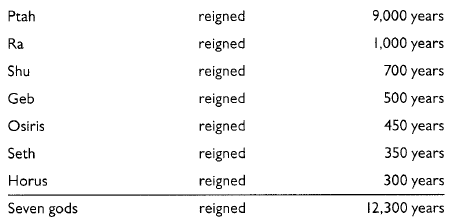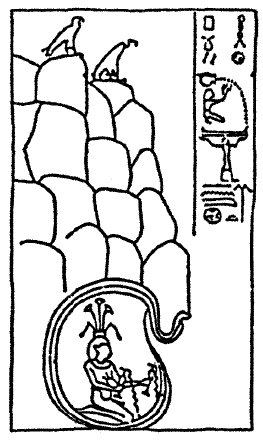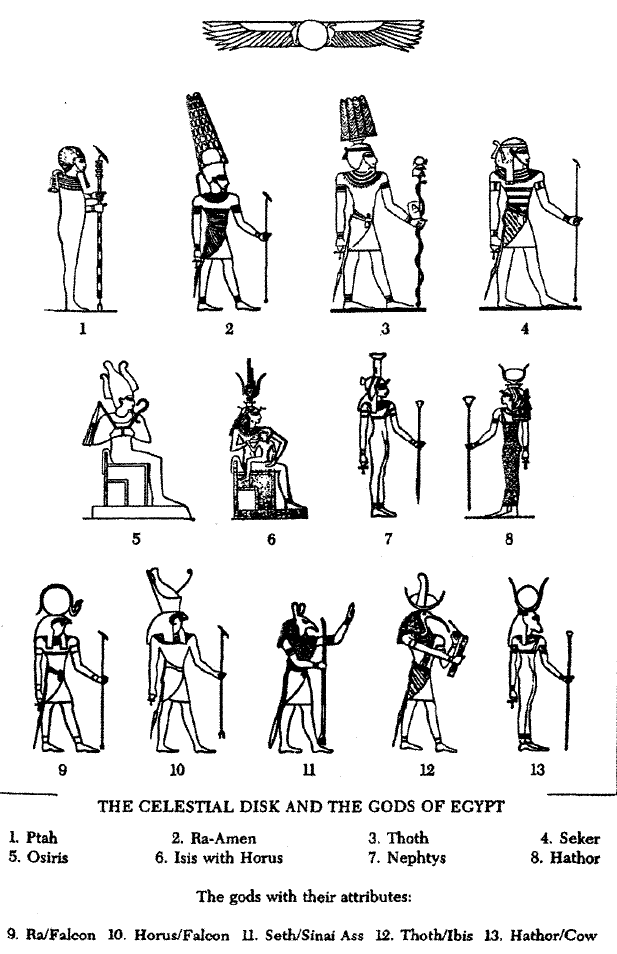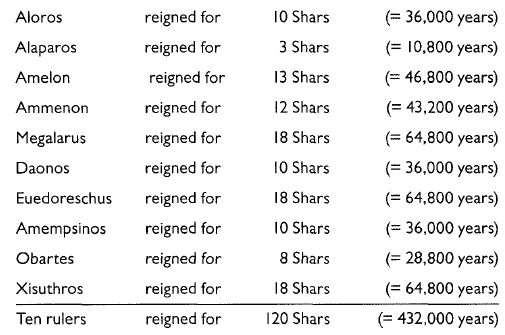|
The original manuscript, known as Aegyptiaca, was deposited in the Library of Alexandria, only to perish there with other irreplaceable literary and documentary treasures in natural and man-made calamities, including its final burning by Moslem conquerors in A.D. 642.
We do know, however, from quotes and references in the writings of others in antiquity (including the Jewish-Roman historian Josephus) that Manetho listed gods and demigods as reigning long before human Pharaohs became kings in Egypt.
True to apparently the same sources, Manetho's list of Pharaohs also began with one called Men (Menes in Greek); but it was Manetho who was first to arrange the succession of Pharaohs by dynasties - an arrangement followed to this day - combining genealogical affiliations with historical changes. His comprehensive List of Kings gave their names, lengths of reign, order of succession, and some other pertinent information.
Like his father Ptah, Ra was a god "of Heaven and Earth," having arrived in earlier times from the "Planet of Millions of Years" in a Celestial Barque called the Ben-Ben (meaning 'Pyramidion Bird'); it was kept in the Holy of Holies of a shrine in the sacred city Anu (the biblical On, better known by its later Greek name Heliopolis).
Though benefiting from unbridled longevity and playing a role in Egyptian affairs for millennia to come, Ra's reign as Ptah's successor was cut short - abruptly - after a mere one thousand years.
The reason, we shall find, was significant to our quest.
Then, after a chaotic intermediate period that lasted 350 years, with no one reigning over the whole (i.e., both Lower and Upper) of Egypt, Men began the first human dynasty of Pharaohs, ruling over a unified Egypt.
The corroborating finds also include a stone inscription known as the Abydos List, in which the 19th dynasty Pharaohs Seti I and his son Ramses II, who reigned a thousand years before Manetho's time, depict themselves (Fig. 11).
Fig. 11
Carved on the walls of the main temple in Abydos, a city in Upper Egypt, it lists the names of seventy-five of their predecessors, beginning with "Mena."
The Turin Papyrus corroborates Manetho's divine, semidivine, and chaotic-interval lists, and (including subsequent Pharaohs) names a total of 330 rulers, just as Herodotus had been told.
Stelas that served as tombstones and other inscriptions identified the place - located beside a purported Tomb of Osiris - as the burial grounds of First and Second dynasty Pharaohs; the sequence of tombs, from east to west, began with one bearing the name of King Menes.
Petrie identified tombs bearing the names of all of the First Dynasty Pharaohs, and in his masterwork, The Royal Tombs of the First Dynasty (1900/1901), acknowledged that the finds confirmed Manetho's list. Moreover, he found tombs with names of pre-dynastic kings, nicknaming them "Dynasty 0."
Subsequent Egyptologists have identified them as rulers during the Chaotic Period listed by Manetho, corroborating that part of his listings too.
Climate and other data presented in my books The 12th Planet and Genesis Revisited led to the conclusion that the Deluge occurred some 13,000 years ago, circa 10,970 B.C.
It confirms the reality of the Deluge and its timing on the one hand, and the veracity of Manetho's divine and demigod data on the other hand.
On the Nile River's island Abu (also called Elephantine for its shape), near the river's first cataract in Upper Egypt, Ptah formed a cavern in the mighty rocks and installed in it sluices that controlled the river's flow, enabling the ground downstream to dry out - literally, in Egyptian eyes, raising the land from under the waters.
The feat was depicted in Egyptian art (Fig. 12); the modern great dam at Aswan is located at the same site near the first cataract.
His successor bore the name
Geb (meaning 'He who heaps up'), for he engaged in great earthworks
to make the land even more habitable and productive.
Figure 12
Wherever one looks or turns in Egypt, the statues, sculptures, depictions, temples, monuments, texts inscribed and illustrated inside pyramids or on coffin lids or on the walls of tombs - all speak of, name, and depict Egypt's gods and its leading pantheon (Fig. 13).
Whatever had been recorded and depicted before Manetho's days, and discovered after his time, corroborates his
lists of Pharaonic dynasties; why not also
accept the reality of gods, followed by demigods, as rulers in Egypt
preceding human Pharaohs?
His task was much more complex than that of Manetho in Egypt, for his compilation was not limited to one land; it had to embrace many lands, different kingdoms, and diverse rulers who reigned not necessarily in succession but sometimes contemporaneously in different (and sometimes warring) capitals.
It is from those references and quotes, collectively known as "Fragments of Berossus," that we know that Berossus chose to 'globalize' the subject: He chose to write down not the history of one nation or one kingship, but of the whole Earth, not of one group of gods but of all the gods, of Mankind in general, of how it all - gods, demigods, kingship, kings, human beings, civilization - had come to be; a comprehensive history from The Beginning to Alexander's time.
It is from those Fragments that we know that Berossus divided the past Into a time before a Great Flood and the eras after the Flood, and asserted that before there were men, gods alone ruled the Earth.
('Chaldeans' was a term used to describe the astronomically savvy residents of ancient Mesopotamia.)
The Greek historians who quoted Berossus explained that the great lengths of those rulers' reigns were actually given in number units called Shar, each Shar - Saros in Greek - being equal to 3,600 years.
The Greek historian Abydenus, a disciple of Aristotle, who quoted Berossus, made clear that these ten rulers and their cities were all in ancient Mesopotamia and explained how their reign periods were rendered:
Apollodorus of Athens (2nd century B.C.) also reported on the pre-Diluvial disclosures by Berossus in similar terms: Ten rulers reigned a total of 120 Shars (= 432,000 years), and the reign of each one of them was measured in the 3,600-year Shar units.
Indeed, all those who had quoted Berossus affirmed that he listed ten divine rulers who had reigned from the beginning until the Great Flood, treating the Deluge as a decisive event.
The names of the ten pre-Diluvial rulers (rendered as Greek names by those who quoted Berossus) and the lengths of their reigns, totaling 120 Shars, were as shown on page 29. (Though the sequences of succession varied, all quotings agree that an "Aloros" was the first and a "Xisuthros" the last.)
The quotings from Berossus indictate that his writings dealt with several issues concerning Mankind itself - how it came to be, how it attained knowledge, how it spread and settled the Earth.
In the beginning gods alone were upon the Earth. Men appeared, according to the Berossus Fragments, when Deus ("god"), also called Belos (a name meaning 'Lord'), decided to create Man. He used for the purpose a "twofold principle," but the results were "hideous Beings."
On the subject of how men attained intelligence and knowledge, Berossus wrote that it came about thus: A leader of those early divine rulers named Oannes waded ashore from the sea and taught Mankind all aspects of civilization.
Berossus reported that although Oannes looked like a fish, he had a human head under the fish's head, and had feet like a man under the fish's tail.
This Oannes,
It was Oannes, according to the Fragments recorded by Polyhistor, who put in writing a tale that explained how Mankind came to be, Creation having been preceded by,
The Berossus Fragments then include details regarding the defining event, the Great Flood, that separated the era of the gods from the times of men.
According to Abydenus, Berossus reported that the gods kept knowledge of the coming devastating Deluge a secret from Mankind; but the god Cronus (in Greek legends, a son of the god Uranus = Sky and the father of the god Zeus) revealed the secret to "Sisithros" (= the last-named Xisuthros of the ten pre-Diluvial rulers):
To find out whether the Deluge had ended, according to the Abydenus quotes, Sisithros released birds to see if they would find dry land.
When the boat reached Armenia, Sisithros made sacrifices to the gods. He instructed the people who were with him in the boat to go back to Babylonia; as for himself, he was taken by the gods to spend the rest of his life with them.
After reporting that,
Following these instructions Xisuthros built a boat, "five stades long and two stades wide."
Anticipating some raised eyebrows from the other townspeople, Xisuthros was instructed by his god to just say he was,
He then put on board his wife and children "and closest friends."
On the third try, the birds did not return and Xisuthros inferred that land had appeared.
After the boat ran aground, Xisuthros, his wife, his daughter, and his pilot went ashore, and were never seen again,
Those who were left behind on board were told by an unseen voice that they were in Armenia and were instructed to return to their land and,
This they did:
According to the Fragments, Berossus wrote that at first,
But Belus, sending forth a whirlwind,
When the waters subsided, both released birds to see if dry land reappeared (Noah sent two birds, first a raven, then a dove). Sisisthros's boat came to rest "in Armenia"; Noah's ark came to rest in the "mountains of Ararat," which are in Armenia.
We have quoted above the Berossus version; like it, the Bible begins the tale (in Genesis 11) with the statement that at that time,
Then the people said,
Berossus states the same thing: People set out,
In the Bible, God ("Yahweh"),
He got concerned and,
Berossus ascribes the Confounding of Languages to The Lord ("Belus") and attributes Mankind's scattering to the deity's use of a Whirlwind.
The translation, still extant and available, is known as the Septuagint ("Of the Seventy") because it was carried out by a group of seventy scholars.
A comparison of its Greek text with the Hebrew Bible leaves no doubt that those savants had already in front of them the canonized version of the Hebrew Bible as we know it today - a Bible that was already in its final form before the time of Berossus (and Manetho).
A most significant difference occurs in the Creation of Man tale, with its terrifying mishaps in the Berossus version, in contrast to the smooth,
There are detail differences even where the two versions dovetail, as in the Deluge story in regard to the size of the ship and, more importantly, as to who was taken on board to be saved.
Some of the differences are not insignificant: According to Berossus, there were on board, beside the immediate family of 'Noah', also several of his friends, as well as a skilled pilot; not so in the Bible that listed just Noah, his wife, and their three sons and their wives.
This is not a minor matter: If true, then post-Diluvial Mankind, genetically and genealogically, does not stem solely from one Noah and his only three sons.
By claiming that pre-Diluvial records of "Beginnings, Middles, and Ends" not only had once existed but were hidden for safekeeping and were retrieved after "Babylon" was resettled, Berossus could have sought legitimacy for his version of prehistoric events; but he also suggested that those Records of the Past contained clues to the Future - what the Bible, and we nowadays, call 'The End of Days'.
Though the theme of linking the Future to the Past is part of biblical prophecy, in the Bible it is first mentioned in respect to Jacob - long after the Deluge.
But in such a conclusion, both similarities and differences take us back to our starting point, the enigmatic verses in Genesis 6:
THE SHIP OF NOAH
In the Akkaddian texts it was referred to as a Tebitu, with a hard 'T', meaning a submersible ship; the biblical redactor rendered it with a soft 'T' - a Teba - a 'Box' (hence the 'ark' in translations). In all versions, it was hermetically sealed with bitumen but had one openable aperture.
Genesis 6:15 also reports a length of 300 cubits, but only 50 cubits (about 88 feet) of width, and only 30 cubits (about 53 ft.) height, with only 3 stories (the roofed upper one included).
Those modern proportions of length/width/height seem to agree more with the biblical description: Noah's Ark was as long as The City of Rome, as wide as The Great Eastern, and as high as The Lusitania.
|





